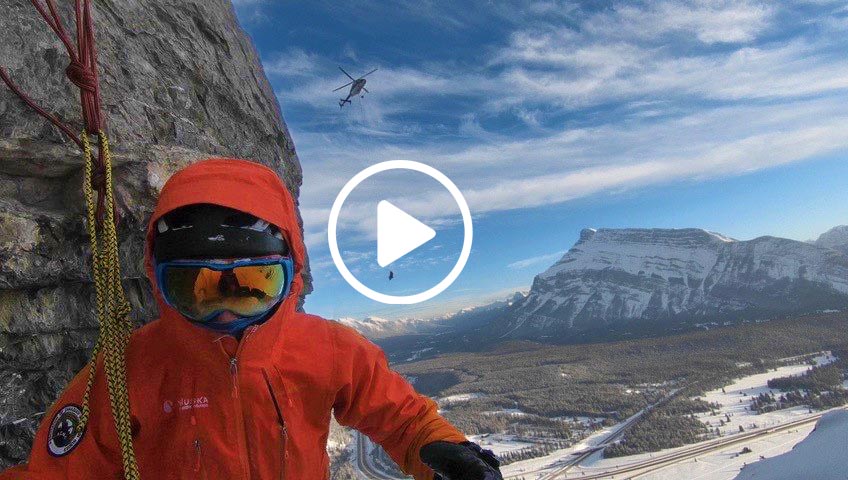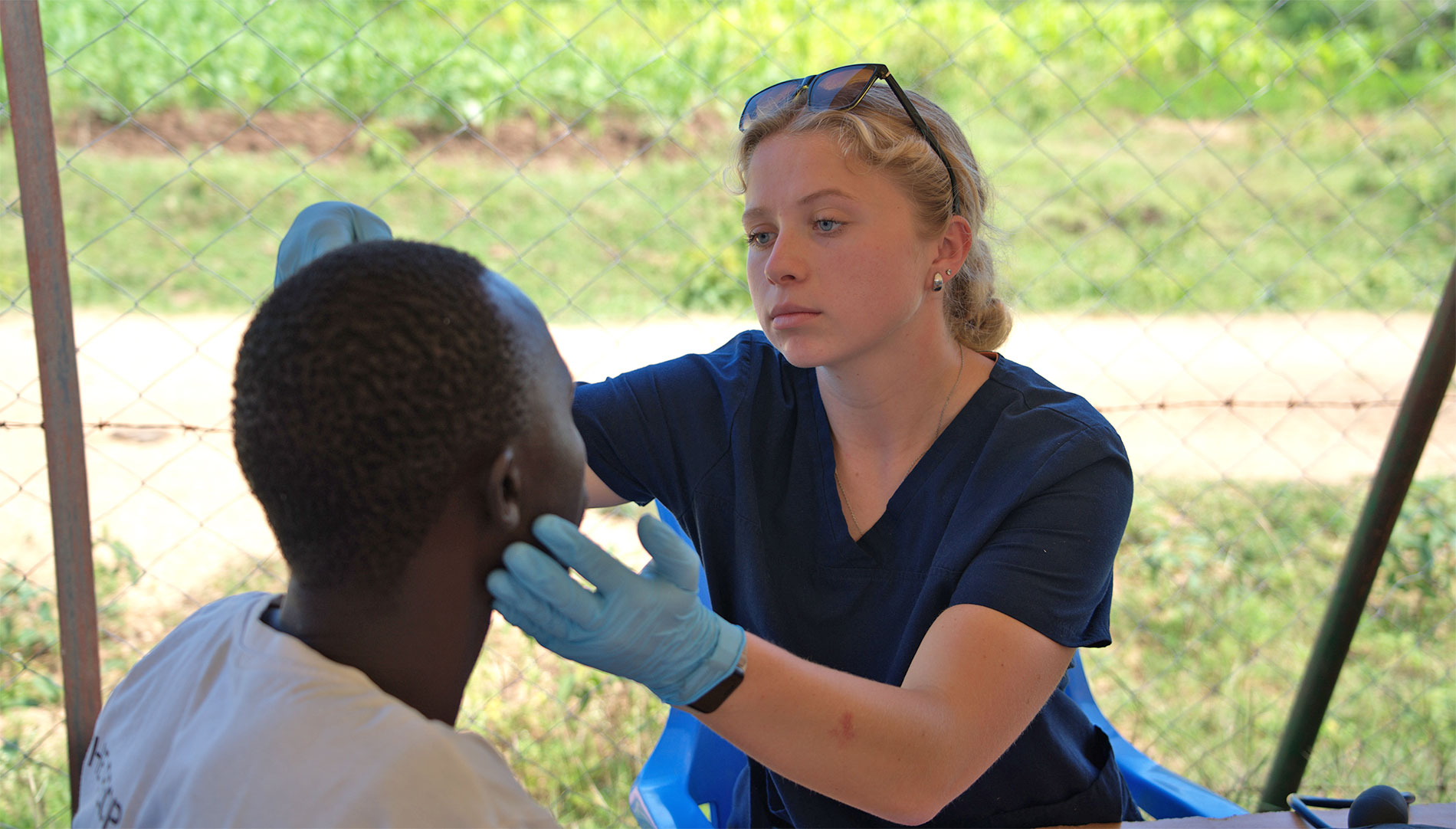By Rick Woodall
Climbing photography by Patrick Delaney of Yamnuska Mountain Adventures
Gerald L. “Jerry” Blanchard (75C) was perched on a sheet of near vertical ice, hundreds of feet in the air, when it happened. Only 60 feet from the top of Canada’s frozen Cascade Falls, the experienced climber kicked the razor-sharp crampon on his boot into the ice, only to feel his foot slip free and see his boot go flying. A loose shoelace hidden by his pant leg was the culprit.
“We’re a thousand feet up in the air, and there goes the boot,” he recalled ruefully.
A decorated banking attorney who now teaches at Emory University School of Law, Blanchard has always enjoyed a good intellectual challenge, and this was a doozy – how to complete the climb with a boot on one foot and a sock on the other, all in temperatures bottoming out at an absolutely bone-chilling minus 30 degrees Fahrenheit.
After sizing up his situation – fast – Blanchard devised a plan with longtime guide Pat Delaney, who was above him on the ice. The two climbers were connected by a safety rope, which Delaney would pull tight as Blanchard slowly made his way up the falls, using the ice axes in his hands and the crampon on his remaining boot.
“He’s up there, he’s got the rope tight, and I’m throwing the ice axes above my head, clunk, and then I’m hopping with my right foot,” Blanchard described. “I’m literally hopping – kicking it in – and then I yell, ‘Pull!’ He pulls up the one or two feet of rope to make it tighter, and then I throw the ice axes in again.”
And so it went, all the way to the top, but Blanchard wasn’t out of the woods yet. By now, hypothermia and frostbite were setting in, and there was no way to climb down with only one boot.
Enter the Alpine Helicopter Co., which carried rangers from Banff National Park to the stranded climber. Harnessed to one of his rescuers, Blanchard was ferried to an open field below and then to a local hospital where he was left with “nasty” blisters all over his exposed foot, one the size of a silver dollar, but otherwise no worse for wear.
“Everybody says, ‘Did they pull you up into the helicopter?’” Blanchard laughed. “No, no, they didn’t pull me into the helicopter. They just pluck you off the mountain, and you go flying at the end of this long line.”
And then he added with a smile, “One thing I will tell people, if you pay your admission to the park, they will rescue you for free.”
Finding his footing
Blanchard was already out of law school when he discovered climbing, but he has always loved the outdoors, dating back to his childhood growing up on seven acres of land adjoined by forests in Howard County, Md., located between Baltimore and Washington, D.C.
After high school, the competitive runner found his way to Berry – enduring a winding, 21-hour Greyhound bus ride for his initial campus visit – which turned out to be the perfect destination for someone looking to challenge both his body and his mind.
“One of the highlights was being able to go out the back door of the dorm and go for a 10-mile run, just running through the campus,” he related. “On the weekends, if I just wanted to go for a run, I would run back to the Academy, back through the woods, basically.”
When he wasn’t running for pleasure or training with his cross-country teammates, Blanchard was pursuing his dream of a career in law. As an interdisciplinary major focused on history and political science, he blossomed under the demanding yet supportive tutelage of the late Dr. Gordon Carper, among others.
The aspiring lawyer learned right away that he had better be ready to “stand and deliver” when called upon by Carper, a skill that would serve him well as a law student at Emory University and during his long legal career that followed.
“Many of my classes would only have five or six people in them, and we would actually go to the professors’ houses and sit there around the living room and chat about the subject,” he noted of his time at Berry. “I just wouldn’t have been able to get that same level of attention anywhere else, I don’t think.”
Starting his ascent
Blanchard was working as an in-house attorney for what is today Bank of America when he caught the climbing bug, signing up for a rock-climbing course while attending a bankruptcy seminar near Wyoming’s Grand Teton National Park.
Recounting the experience, Blanchard described, “This guy comes out, and he’s got a full head of gray hair and a gray beard, kind of like a little gnome. He teaches us how to tie the ropes around ourselves, how to wear the harnesses, the knots, all this kind of stuff, and then he goes to this rock face, and he just starts scampering up like a cat. He gets up to a cliff and looks down and says, ‘OK, now it’s your turn.’ And one at a time, we have to climb this rock face to the cliff that he’s on.”

It wasn’t easy, but Blanchard was hooked. When he returned to Atlanta, he immediately began taking rock-climbing courses. Many years later, he remains enthralled.
“It’s not always straight forward,” he related. “Let’s say you’re looking up and you see a ledge. There might be three ways of getting to that ledge. Which is the least risky way? Which way am I going to have to expend the least amount of energy? Because you’re trying to conserve energy. So it’s an intellectual challenge as well as the physical challenge.”
The rewards of overcoming such challenges can be considerable. During an early climbing adventure, Blanchard found himself alone with his guide atop Grand Teton, at 13,775 feet the highest point in the park of the same name. They had been the first out of the tents that morning, wearing headlamps in the darkness as they set out to complete the final ascent of the two-day climb. Behind them, pinpricks of light represented other climbers. Ahead, there was nothing but an incredible view.
“That was just the most exhilarating thing to be on top of this mountain,” Blanchard said. “It was a gorgeous day. You could see the shadow of the Grand Teton going into Idaho, and you were at the top of it.”
Taking up his axe
Over the years, Blanchard has tried many different types of climbing – in Colorado Springs, he donned rubber-soled shoes for “friction” climbing on smooth sandstone; back in Grand Teton, he worked his way up “Guide’s Wall” as part of a “crack” climb, which requires you to insert your hands and feet in a crack in the rock and work your way up – but ice climbing rises above them all.
“It’s similar to rock climbing but different from the standpoint that rock climbing you look up and you can see where the next handhold is,” Blanchard explained. “In ice climbing, you’re making your own trail, so to speak.”
The focus is intense, as is the preparation, taking into account temperature fluctuations, ice quality and avalanche risk, among many factors – ideal for someone who has always gotten a thrill out of coming up with solutions to difficult questions, whether it’s on a frozen waterfall or in his law office working with a client.

“It’s energizing and refreshing,” he said of climbing. “It clears the mind of whatever else you’re worried about, because you can’t worry about anything else.”
Since getting his first taste of ice climbing in Iceland in the early 2000s, he’s gone almost every year, mostly in Canada.
His family, including wife Teresa Hargrove Blanchard (75C), who owns her own CPA firm, understands it’s his way of “howling at the moon.” But you won’t find her or their adult children, son Jonathan and daughter Melanie (05C), with him on the ice.
“They accept the fact that I find it interesting,” he said, “but they don’t have any interest in going up there to do it.”
Blanchard, who will be 68 in August, just keeps “howling.” His last climb was in early 2020, just before the onset of the COVID-19 pandemic. Opportunities have been limited in the year since, but when you hear him describe the sensation of taking that first swing of the axe at the base of a frozen waterfall, with snow all around and nothing but a blue wall of ice in front of him, it’s easy to imagine him taking up the challenge once again.
“It’s all those kinds of things that you have to learn about climbing and visualize as you’re looking at something that I get a big kick out of,” he said. “It’s not like climbing a ladder, I guess you would say. If it was a ladder, everybody could do it.”

wife Teresa and son Jonathan.
Berry family
When Jerry Blanchard (75C) arrived at Berry in 1971, he had no idea he was starting a family tradition.Two years after that first long bus ride from Maryland, brother and future doctor Michael (77C) joined him. Both found love on campus, with Jerry marrying Teresa Hargrove Blanchard (75C) and Michael meeting wife Anneliese Rogers Blanchard (79C).
In 2001, a new generation arrived when Melanie Blanchard (05C), daughter of Jerry and Teresa, chose Berry as her undergraduate destination. Now a collections management specialist at the Smithsonian’s National Museum of American History in Washington, D.C., she thrived under the direction of the same academic advisor as her father, Dr. Gordon Carper.
“To be honest, I never would have imagined that it would have been possible,” Jerry said. “It was just a lot of fun to watch her develop her intellectual skills and her people skills at Berry and have the relationship with Gordon and his wife that Teresa and I had back when we were there.”




